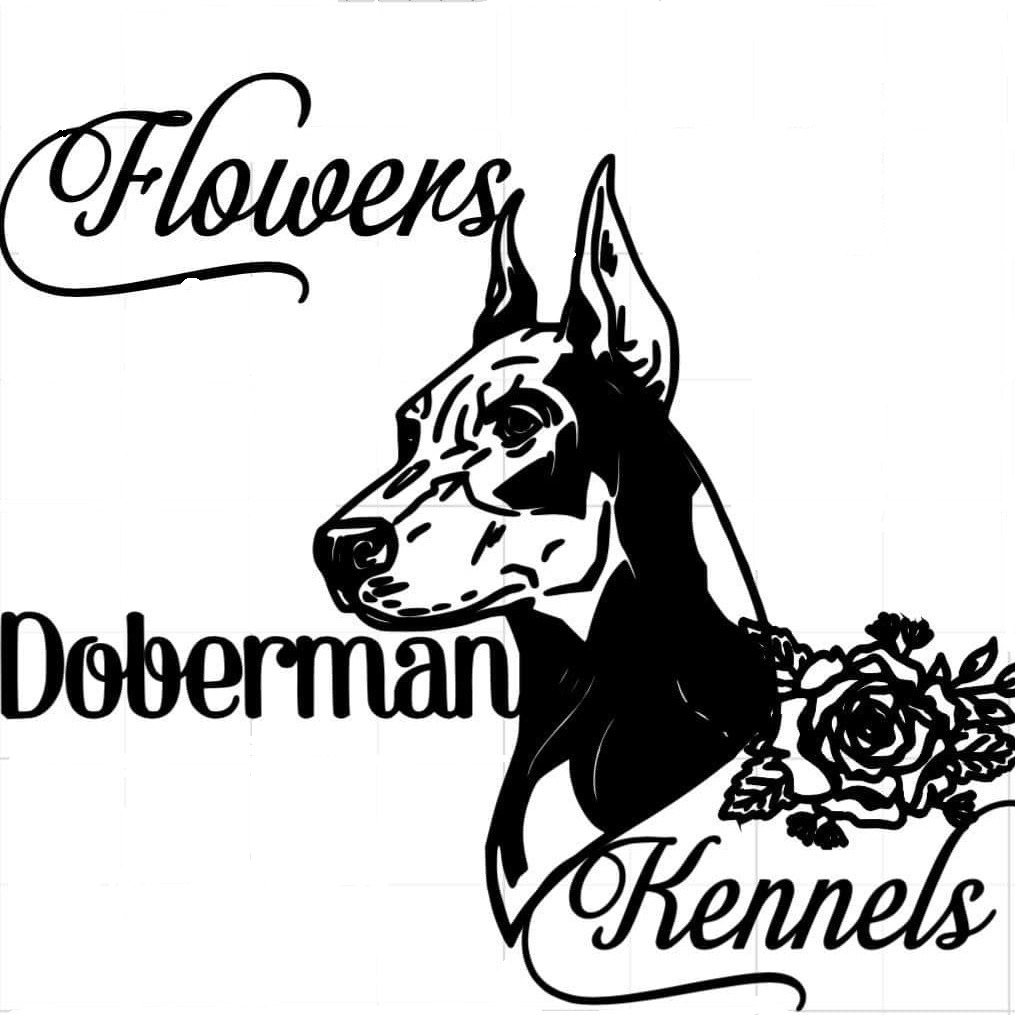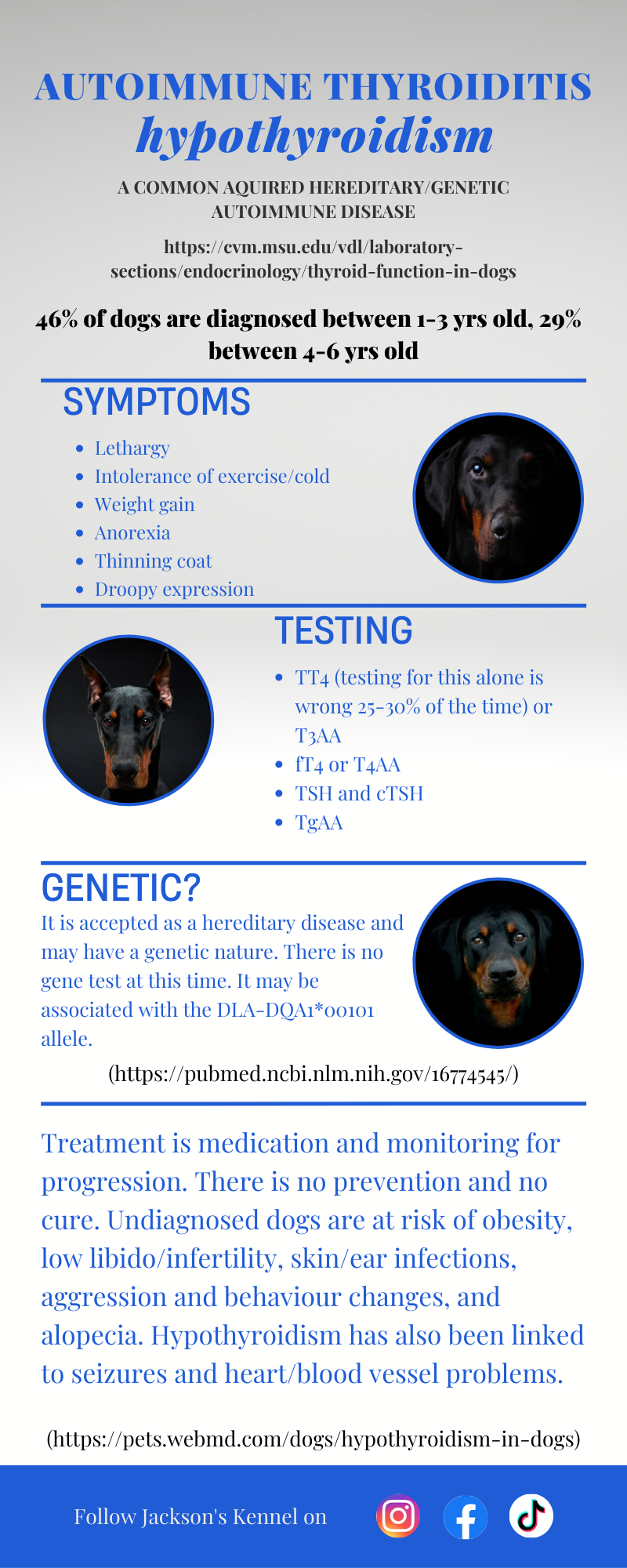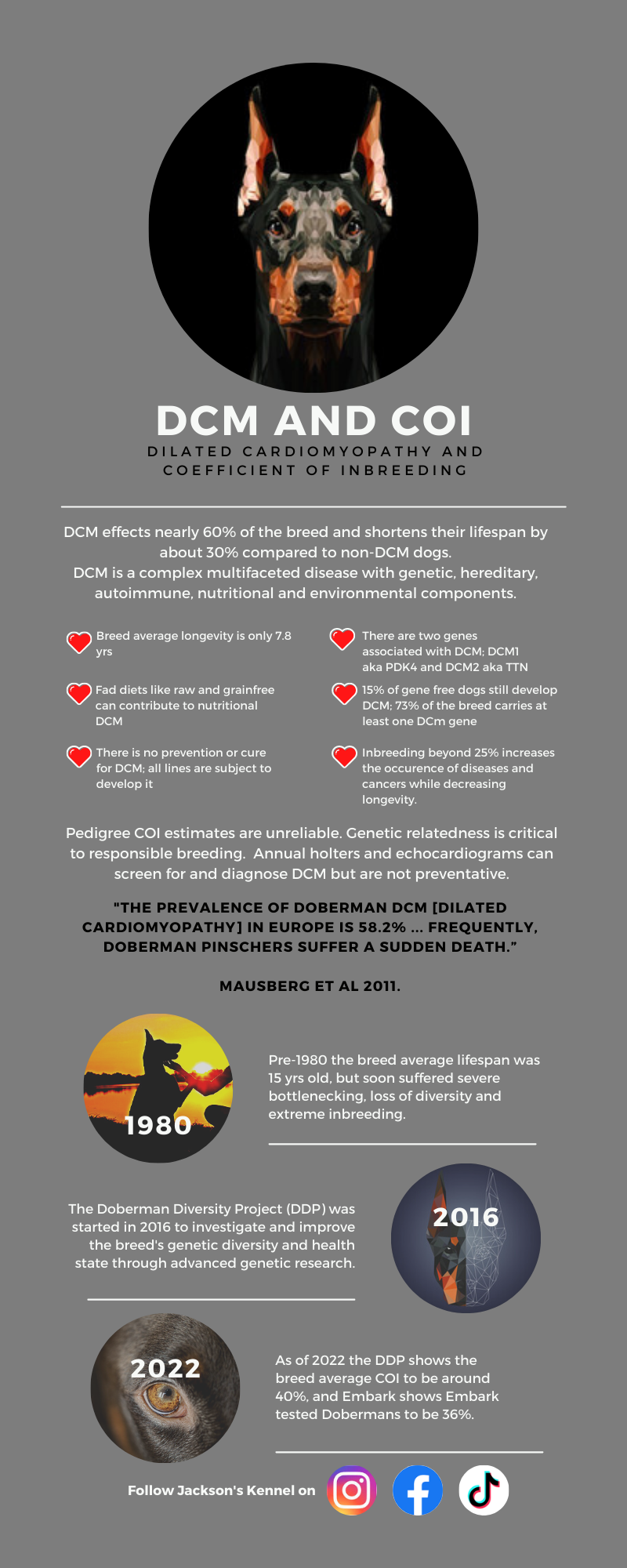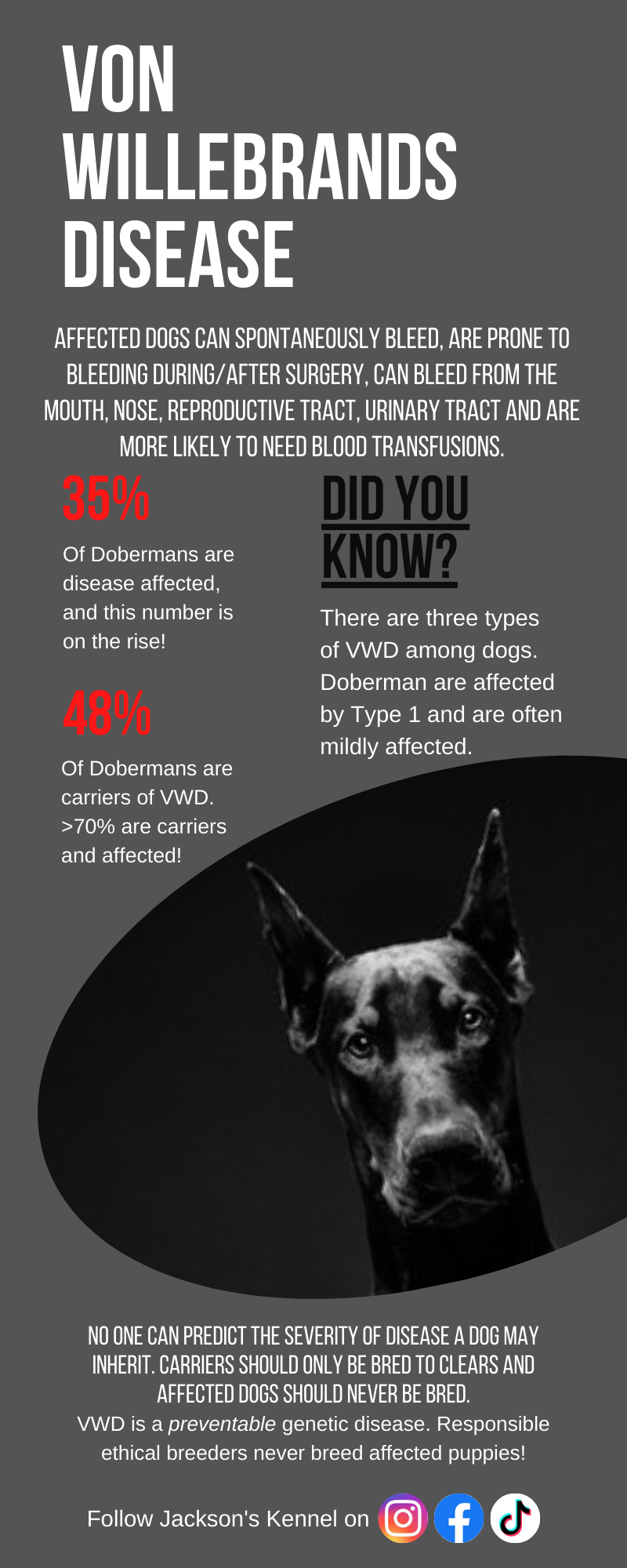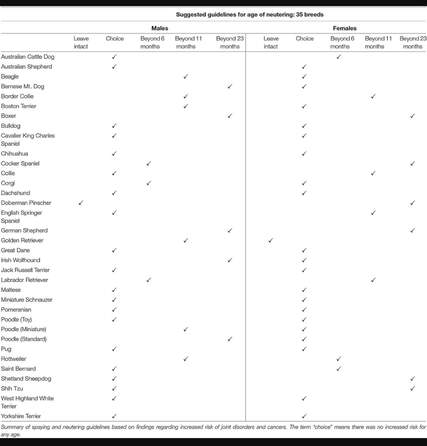Quick Facts:
|
Lifespan: 8-10 years
Breed Class: Working Group Grooming: Easy, Short hair Ownership Expertise: Advanced Trainability: Easy, intelligent Size: Medium to Large, 60 - 100 lbs Energy Level: Active, can be hyper, needs daily mental stimulation and physical exercise Notes: Prone to separation anxiety, stubbornness, and destructive boredom, Velcro - will want to be where you are at all times Myth Buster: Brain will not outgrow the skull, They are not more likely to turn on their owners, They are not mean dogs/it is how you raise them |
As a Breed Doberman are Prone to:
|
Heritable Conditions in Doberman
- Von Willebrand's Disease (VWD) - an inherited bleeding disorder requiring 2 defective genes (autosomal recessive), carriers, or dogs with only 1 defective gene, are unaffected and can not have VWD. Carrier bred to a clear, or dog without a defective gene, will never produce puppies affected with VWD. A carrier bred to a carrier will produce some puppies affected with VWD. A carrier bred to an affected dog will produce affected puppies. Read more about VWD here.
- Liver Disease and Copper Toxicity - Over 20% of Doberman in a random population study were found to have copper accumulation and subclinical hepatitis. Read more here Hepatitis
- Degenerative Cardiomyopathy (DCM) - see my page on DCM here
- Doberman Vestibular Deafness (DvDOB, aka Dings) - genetic congenital deafness that effects up to 13% of dogs (13 out of 100 Doberman; may be unilateral or bilateral): https://www.dobermandiversityproject.org/dings.html
- Cervical Spondylomyelopathy (aka Wobblers Syndrome) - There is no gene associated with CSM/Wobblers, and there is no breeding screening for the disease. While no gene is currently identified it is considered an autosomal trait with incomplete penetrance. "Wobbler syndrome is a disease of the neck (the cervical spine) that is seen in large and giant breeds of dog. These dogs experience compression of the spinal cord and the spinal nerve roots, resulting in nervous system deficits and/or neck pain. Approximately 50% of the cases of wobbler syndrome seen in dogs occur in Doberman pinschers, and other breeds commonly affected include the Weimaraner, Great Dane, Rottweiler, and the Dalmatian. Despite certain breed predilections, any dog breed may be affected, including small dogs."- VCA, 5.5% of Doberman develop CSM, Read more about Cervical Spondylomyopathy here
- Genetic Research Opportunity for Wobblers: FREE genetic test to dogs dx with Wobblers (open to any breed)
https://embarkvet.com/breeders/wobbler-syndrome-help-us-learn-which-dogs-may-be-at-risk/
- Genetic Research Opportunity for Wobblers: FREE genetic test to dogs dx with Wobblers (open to any breed)
- Lower resting levels of ALT activity - a low normal GPT levels can be mistaken for illness or disease (benign)
- Lower Resting GPT Levels - Alanine Aminotransferase Activity (GPT) Genetic (inherited) Dobermans with two ancestral G alleles show "normal" activity. Dogs that have one or two copies of the derived A allele on Chromosome 13 may have lower resting levels of ALT activity, known as "low normal". If your dog's result is "low normal" then when a blood chemistry panel is being interpreted the values that you and your veterinarian consider "normal" may need to be adjusted. Please note that neither a "normal" nor a "low normal" result for this predicts a disease state or increased risk for liver disease. Moreover, this mutation does not associate with increased levels of ALT: If your dog has high ALT levels, please consult your veterinarian.
- CITATIONS: White et al 2016
- Autoimmune Thyroiditis - Also called autoimmune hypothyroidism, and is thought to be a recessive hereditary disease and is associated with lethargy, anorexia, hair loss, weight gain, Dobermans with hypothyroidism may be more likely to develop DCM. You can read more about DCM and hypothyroidism here. You can read more about autoimmune thyroiditis and hypothyroidism here.
What Else to Look Out For
- Bloat - There are two variations of Bloat, 1) gastric dilatation and volvulus (GDV) - the stomach fills with gas and the stomach twists on itself 2) gastric dilatation (GD) - the stomach fills with gas. Both conditions are dangerous and can be lethal fast. Both require emergency treatment. Read more about Bloat here.
- Obstruction - Any dog is prone to get a bowel obstruction by eating things that are either indigestible or that clog the small intestine. An obstruction is a life threatening emergency and require immediate care. Often obstructions are caused by eating items like blankets, bedding, toys, socks, clothes and rocks. Any thing can be a potential blockage hazard, even grass. Some blockages can be removed using an endoscope but most require surgery, possibly even removing part of the small intestine.
- Idiopathic Head Tremors (aka Benign Head Shake, IHT) - A mild head shaking in a "horizontal no or a vertical yes" manner; "Episodic head tremor is an inherited, paroxysmal movement disorder(1)". It is not a neurological disorder, not a seizure, and often not indicative of underlying illness or disease, and has no connection to Wobblers Disease. Read more about IHT here and here. You can think of IHT as a form of anxious shaking or nervous, possibly brought on by drastic emotional swings such as fear, excitement, anticipation. IHT is strongly hereditary in Doberman. There are two forms of the condition; familial and sporadiac. https://pubmed.ncbi.nlm.nih.gov/21915908/(1)
- Separation Anxiety - Doberman are extremely social dogs, often termed Velcro dogs for their desire to be with their bonded human(s) at all times. Being such an emotional and sensitive breed has a potential backfire; if not properly socialized and trained a Doberman may develop behavioral outbursts like whining, pacing, digging, chewing, destructive behavior, howling, crying, screaming, flank/leg sucking/chewing, hair loss and shaking. Read more about Separation Anxiety here.
- Flank Sucking/Chewing and Blanket Sucking - Blanket suckling and flank sucking/chewing are forms of calming, stimming, and self-soothing behaviors in dogs, often seen in Doberman, but can be a potential health hazard. These behaviors are often hereditary and associated with obsessive compulsive disorders and pica. They are not associated with early weaning or premature separation from the mother. You can read more about Blanket/Flank Sucking/Chewing here and here. It's crucial to discourage the behavior(s) immediately when they start and offering safer alternatives such as a chewing tasty treat or flavored chew toy.
- Light Chasing - Light Chasing is another form of OCD behavior behavior in dogs. It occurs when the dog's prey drive instinct kicks in to hunt and capture its prey. It can be distressing to the dog to not be able to catch its prey. This often leads to obsessive compulsive chasing. Some dogs become destructive as they try to catch the light, tearing up floor digging at the light, shredding furniture as they bite at the light beams. Some dogs develop the behavior by chasing laser beams (pointer lights) which leads to chasing any beam of light. Read more about Light Chasing here. I recommend not using laser lights, flashlights, or other beams to engage your dog. Alternatives are tug-of-war, fetch, Frisbee, stimulation toys, puzzles and scent games.
- Canine OCD - fly-snapping, tail chasing, tail biting, paw licking, floor licking, pacing/spinning; these are stimming behaviors and help soothe a stressed dog or are habitual routines (such as to fall asleep). Medication may help calm these behaviors making your pet more comfortable. OCD is often genetic and can be hereditary (running in families), it can originate from trauma, may be a pattern established from boredom (such as being crated for extended periods of time). You can red more about Canine OCD here.
- Same Sex Aggression (SSA) and Interdog Aggression (IDA) - SSA is where members of the same sex, typically at sexual maturity, display aggression and dominance over others of the same sex. IDA is where members of the same household suddenly develop aggressive behaviors with each other where they once seemingly got along with few or minimal fights. SSA and IDA can lead to territorial fights and injury. Intact males are at no increased risk of SSA than neutered males, although in females spayed females, especially those spayed early, are more likely to have SSA. Read more about the aggression of intact vs neuter SSA here and here. Here is a great article on inter-sex aggression. (Dominance is a relationship-related behavior and not necessarily a personality trait or flaw.)
- Cancer - Purebreds are more prone to cancer with 27% of UK dogs passing away from cancer in the 2000s. There is no way to predict if a dog will develop cancer or not. Cancer has many components. It can be hereditary, meaning it runs in families. 47% of dogs over 10 years old have some form of cancer. There are some environmental factors that attribute to a dog developing cancer. "Known carcinogens that may directly contribute to the development of cancer in pets include ultraviolet radiation from long exposure to the sun; second-hand tobacco smoke; a variety of herbicides, insecticides, and pesticides commonly used in agriculture; and the air pollution and smog common in many urban areas. Nickel, uranium, benzidine, benzene, radon, vinyl chloride, cadmium, and asbestos are all common substances that have been identified as carcinogens."
- Coat Dilution Alopecia (CDA, aka "Blue Dog Syndrome") - CDA is a form of permanent hair loss as a direct result of the "diluted" color/hair follicle shape. It is a benign condition; although an unsightly one. Blue and fawn Doberman are subject to develop the condition, as are many other breeds with dilute coats. https://vcahospitals.com/know-your-pet/color-dilution-alopecia-in-dogs The condition is due directly to the D lotus. There is not a gene specific to the disease and it can't be bred out of dilutes. Case study of a blue Doberman with CDA: https://www.askjpc.org/vspo/show_page.php?id=Z0s5Vm5hVmtYak5TVjZ2MjlHK2gxUT09 Melatonin has not been show to cure nor treat CDA nor alopecia in Doberman, but it has limited aid in seasonal alopecia. CDA is not a form of seasonal alopecia. Melatonin is a hormone and should not be used without veterinarian guidance. Melatonin is a great aid in hair growth and thickening.
- Digestive issues - Doberman as a breed are prone to food sensitivities, food allergies and food intolerance. The most common symptom is diarrhea. A true allergy is an immune reaction and a medical emergency. Most often a "allergy" is actually a sensitivity or intolerance or an imbalance of gut flora. https://vcahospitals.com/know-your-pet/adverse-reactions-to-food-in-dogs
- High Inbreeding Rations (COI) - The Doberman breed has an average COI (coefficient of inbreeding) of 36-43% and a longevity average of only 7.5 yrs old, even low COI Dobermans are still highly inbred (25%+). At the current rate of diversity loss the Doberman's population is unsustainable.
Visit the AVMA (American Veterinarian Medical Association) for the most current pet care information and advice.
https://www.avma.org/public/PetCare/Pages/default.aspx
https://www.avma.org/public/PetCare/Pages/default.aspx
Health & Genetic Testing
Genetic testing for zygosity is affordable and highly recommended for any dog prior to interests in breeding. Purchasing kits are simple and quick. Most kits use a non invasive cheek swab. You can purchase them at:
www.vetnostic.com
www.vetgen.com
www.gensoldx.com
www.animalab.com
www.amva.org
www.pawprintgenetics.com
www.wisdompanel.com
www.animalgenetics.us
We us Embark as the standard for genetic testing all our dogs as well as GenSol for individual genetic testing. Remember; carriers are equally as important as clears. Genetic testing is more about finding out what makes up your dog, the good, the bad, and the all in between. carriers are essential to the breed population and vital to diversity genetics!
www.vetnostic.com
www.vetgen.com
www.gensoldx.com
www.animalab.com
www.amva.org
www.pawprintgenetics.com
www.wisdompanel.com
www.animalgenetics.us
We us Embark as the standard for genetic testing all our dogs as well as GenSol for individual genetic testing. Remember; carriers are equally as important as clears. Genetic testing is more about finding out what makes up your dog, the good, the bad, and the all in between. carriers are essential to the breed population and vital to diversity genetics!
You can also look into OFA or PennHip certifications. PennHip is more accurate and tests start as early as 4 months old. OFA is less accurate but more marketed and more vets participate in the program. Eyes, hips, ears (BAER), elbows and such are all subject to certification. - Bare in mind there is no definitive screening to avoid hip dysplasia as it is not as much genetic as it is environmental and dietary. We use PennHip as our testing method and send those results to the OFA.
Flea & Parasite Control
Our puppies leave with flea medication and heartworm prevention started at 7-8 weeks old. Frontline Spray is started at 2 days old and given again at 6-7 weeks old. Please note it can take up to 10-14 days for flea medication to be fully effective. Your puppy may come home with some fleas. Do not be alarmed. Flea control is not 100% effective in killing all fleas; larva can still mature into adult fleas but they will be unable to lay eggs. Some fleas do survive the medication or develop immunity to it. Our puppies leave started on monthly flea and heartworm prevention. As long as you maintain your monthly flea control you shouldn't have any problems with fleas or heartworm.
We required monthly deworming of your Jackson's Kennel Doberman. Once your dog is an adult (2 yrs old) it is recommended to deworm every 3 months. Parasites are found literally everywhere and any skin contact can contract them. Walking through grass, sniffing butts, licking fur, sniffing other dogs poop, eating dog food, eating grass, and so on; eggs, larva and matured parasites are everywhere. The Companion Animal Parasite Counsel recommends to deworm every month.
External Parasite Info: https://www.avma.org/resources/pet-owners/petcare/external-parasites
We required monthly deworming of your Jackson's Kennel Doberman. Once your dog is an adult (2 yrs old) it is recommended to deworm every 3 months. Parasites are found literally everywhere and any skin contact can contract them. Walking through grass, sniffing butts, licking fur, sniffing other dogs poop, eating dog food, eating grass, and so on; eggs, larva and matured parasites are everywhere. The Companion Animal Parasite Counsel recommends to deworm every month.
External Parasite Info: https://www.avma.org/resources/pet-owners/petcare/external-parasites
| studies_of_lyme_disease_bartonellosis___american_canine_hepatozoonosis_in_dogs_focus_on_prevalence___understanding_dogupdatesumr2019.pdf |
Spay and Neuter
Spay/neuter is an elective surgical procedure that has life-long medical implications and risk for your pet. It will change how your pet's body works. Male dogs benefit from a low protein diet after neutering. Neutering increases the risk of weight gain/obesity. UC Davis found the age a male Doberman is neutered doesn't effect it's health (ligaments, cancer risk, etc.) and to spay females after 23 months old, otherwise there is an increased risk of cancer and ligament rupture. We recommend waiting until your pet's growth plates have finished fusing to alter your pet. If you have no intention of breeding but want to preserve the use of hormones a hormone sparing alteration is the best alternative to a traditional spay/neuter. Spaying and neutering remove essential hormones from your pet and does have an impact on your animals health and longevity, including an increased risk of cancer, obesity, mood disorders, hormone disorders (obviously), and more. When you alter your pet be prepared for the increased risk of thyroid disease, diabetes, liver disease, cardiac disease, and cancers, as well as joint and ligament degeneration. We recommend altering any dog that is not being competed, titled, shown or bred.
Things to consider after altering your pet are:
- Spay/Neuter Incontinence - males can develop incontinence too
- Hormone Imbalances
- Gut/Digestive Issues
- Mood Instability/Changes
- Personality Changes
- Loss of Population Genetic Potential
- Increased Risks of Cancers and Autoimmune Disease
- Spay/Neuter Coat Blowing/Dulling
